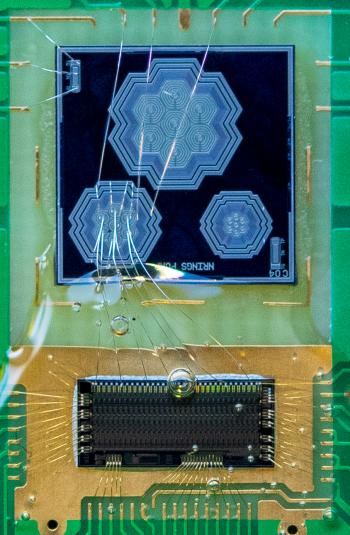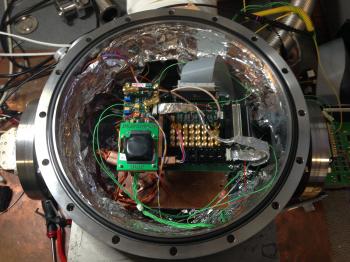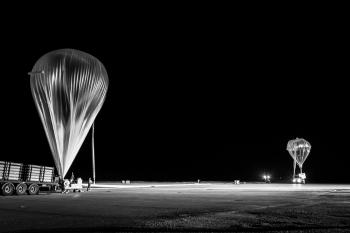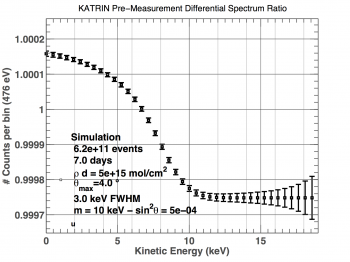
Simulation of a 10 keV sterile neutrino signal in the KATRIN experiment, as designed. The whole tritium beta-decay spectrum is recorded for 7 days. Credit: T. Lasserre.
Systematics studies and sensitivity computation
A new simulation package has been developed at CEA for studying the sensitivity of KATRIN to search for keV-scale sterile neutrinos.
Studies are being performed on theoretical corrections to the Fermi theory, decays through the molecular excited states, detector induced systematics, emission of Auger electrons from the KATRIN rear-wall, scattering of electrons in the tritium source, backscattering on the silicon detector, high-voltage fluctuations of the main spectrometer, backgrounds, ...
This work contributes to the optimization of the TRISTAN detector design. It is also used to prepare the forthcoming proof-of-concept measurement with KATRIN in 2017.
Detector Prototyping
Detector prototyping in collaboration with the Max-Planck Semiconductor Laboratory and the Max-Planck Institute for Physics in Munich, Commissariat a l’énergie atomique et aux énergies alternatives (CEA), Lawrence Berkeley National Laboratory (LBNL), Oak Ridge National Laboratory, and Karlsruhe Institute of Technology is ongoing.
At the beginning of 2016 the first silicon drift detectors will be produced at HLL (semi-conductor laboratory Munich). Other detectors are being produced at LBNL (Lawrence Berkeley National Laboratory). Comprehensive tests are being performed to specify the produced detectors.
The CEA readout system
At CEA/Irfu TRISTAN interface boards were prepared to use the CEA IDeF-X ASICs developed by the SEDI for the SAp. The CEA IDef-X ASICs are being used to readout the TRISTAN prototype detectors.
IDef-X_BD (Bi-Directional) is a 32-channel front-end ASIC designed for spectro-imaging devices. The circuit is optimized for detectors with low capacitance (2-5pF) and low dark current (Ileak<1nA). It has been designed to connect detectors at the anode side (current flowing out of the input) or at the cathode side. Each channel consists in a Charge sensitive preamplifier (CSA) with continuous reset and DC coupling, a Pole-Zero Cancelation stage (PZ), a CR-RC4 shaper, an inverter/non-inverter amplifier, a peak detector and a low-threshold discriminator. Peaking times and current in CSA are programmable for the whole chip while Low-Level thresholds (LT) are programmable individually in each channel. In addition, IDef-X BD integrates an absolute (no needs for any calibration) temperature sensor with a 1°C accuracy and a dynamic ranging from -100°C to 30°C. The energy can be sequentially read via an integrated differential AC coupled buffer or via an integrated single-ended DC coupled buffer.
Test Bench at CEA/DRF/Irfu (SAp-SEDI-DPhP)
A dedicated test bench has been mounted at CEA Saclay, based on electronics development done at the SEDI and SAp. It consists of a vacuum chamber cooled at temperature down to -50°C. The TRISTAN silicon drift prototype detectors are installed inside the chamber that also contains the front-end readout electronics and the FPGA. Signals are extracted and sent to the 14 bits ADC outside of the chamber. A thin beryllium window allows for the transmission of X-rays from radioactive calibration sources providing the signals.
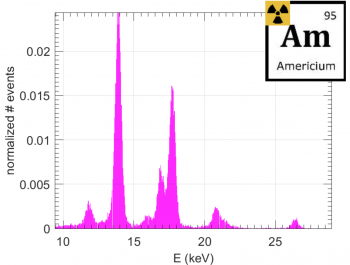
Example of an energy spectrum recorded after the exposure of the detection system to an 241Am radioactive calibration source. Credit: K. Altenmueller.
Results
TRISTAN prototype detectors characterization is ongoing at CEA/DRF/Irfu (Spp and SAp) since March 2016. Detector produced at the HLL Munich and at LBNL Berkeley are being studied. The following figures are currently being measured for prototype detectors of pixel sizes ranging from 0.5 mm to 2 mm: energy resolution, linearity, leakage current, electronics noise, charge sharing, stability, pixel-to-pixel uniformity.
The TJB (TRISTAN Joue au Ballon) balloon flight
A TRISTAN prototype detector was tested in extreme conditions during a stratospheric balloon flight, in partnership with the national center for space research (Cnes). The balloon flew for 12 hours up to 29 km. More information can be found here.
Contacts: O. Gevin (SEDI) - O. Limousin (SAp) - Th. Lasserre (DPhP)

